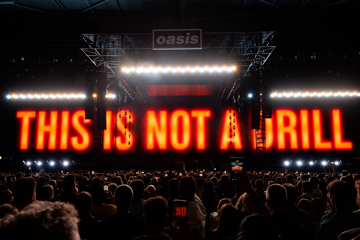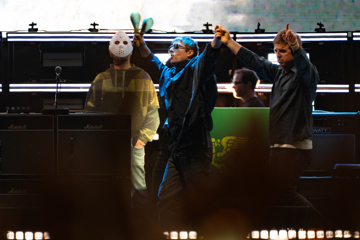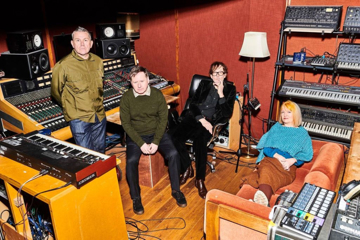'The Lost City Of Z' Is A Rich Epic That Will Have You At Hello
the lost city of z

In 1925, an obsessed British explorer and his son disappeared into the Bolivian Amazon, in search of a fabled lost city. They never returned. This is the prime one-line premise for The Lost City Of Z, which, really, should have you at hello. It’s a true story, based on David Grann’s 2009 book; although, Grann’s writing runs with the facts so much it heads toward fiction, become as much a portrait of the author’s obsessions as its subject’s. In turn, the cinematic vision brought to screen by James Gray is unconcerned with history as it happened. To evoke cinema’s most famous chronicler of egomaniacal-colonialist-journeys-into-the-jungle, Werner Herzog, Gray cares not for the accountant’s truth, only the ecstatic truth.
And, for viewers, The Lost City Of Z has moments of sheer ecstasy. It’s a wide-screen epic rich with glorious jungle imagery, visions of light and dark, and flights of fantasy, that crests at its unexpectedly-sublime end. The film plays, in many ways, like a modernist riff on an old-fashioned matinée: with attractive movie stars —Charlie Hunnam, Robert Pattinson, Sienna Miller— headlining a picture big on historical sweep.
Don't miss a beat with our FREE daily newsletter
Hunnam plays a middle-aged British surveyor who arrives in Bolivia as newly-made company-man, the lack of upward-mobility in his military career —he passed over due to his lack of social standing and dubious bloodline— leaving him to toil for the Royal Geographical Society. At first, he’s merely mapping the terrain to settle a land dispute between Bolivia and Brazil, tensions high at the height of the South American rubber boom. He arrives clueless, and colonialist, but is soon seduced by the jungle. He yearns to know its secrets, and his eventual obsession with this lost city isn’t about greed, only a lust for knowledge. When he encounters the cracked fragments of ancient earthenware crockery, he hauls them back to England; these discoveries, of civilisation having taken hold in South America long before it’s been believed, worth more, to him, than gold.
In truth, Gray doesn’t quite know what to do with this obsession; doesn’t fashion a film that works as picture of obsessiveness. Partly, this seems to be his Gray’s approach: the film having a measured quality, as if evocative of a buttoned-down Englishness. Gray’s five prior pictures —from his modest 1994 debut Little Odessa to 2013’s sepia melodrama The Immigrant— were all set and filmed in New York; Gray making his name as an auteur attuned to the neighbourhoods and communities. Here, he’s operating on a larger, foreign scale: moving from Ireland to England to the Amazon, his film depicting grandeur of vista, and the call of distant lands. The grass —or jungle— remains forever greener for Hunnam’s ill-at-ease explorer; he never feeling at home, forever yearning for the other.
Hunnam plays his main character with an earnest straight-forwardness that matches Gray’s approach (there’s few laughs, here). Hunnam, with his unalloyed blonde handsomeness and boyish enthusiasm, is hardly one to lose himself in a role; and, in turn, his main character manages to feel somewhat generic, even as he’s delivering a stirring oration in front of the House of Commons, leading men into battle in WW1 France, or sitting down to dinner with some local cannibals.
That stands Hunnam in contrast to his co-stars: Miller managing to overcome the seeming simplistic revisionist hue of her character (she literally says, aloud, in the opening act, “I’m an independent woman”), and the constraints of the wife-left-back-home role, to deliver a vivid, memorable turn. And then there’s Pattinson, who, unlike Hunnam, has a chameleonic ability; who, here, recedes wholly into character. Playing Fawcett’s loyal off-sider —and jungle veteran who helps the neophyte survive— his carved jaw is lost behind a bristling beard and wire spectacles, his character fidgety and odd, looking on life, and death, from a distance at once wry and critical.
When taken with his electric, equally-unrecognisable leading turn in the Safdie Bros’ Good Time, Pattinson is making an unexpected, audacious claim as one of the cinema’s most interesting stars; be he playing a peripheral Lawrence Of Arabia in the failed Herzog epic Queen Of The Desert, or the manifestation of a naughty boy’s ascension into fascist dictator at the bonkers, Scott Walker-scored climax to The Childhood Of A Leader. His one-time Twilight-co-star/tabloid-flame Kristen Stewart found artistic emancipation by throwing herself into films by bona fide auteurs, and Pattinson is doing the same: upcoming, he’s starring for Claire Denis in an unlikely space-journey thriller, High Life.
Pattinson is great, here, but it’s, really, Gray’s show. The Lost City Of Z is essentially a film about dreams: of foreign shores, of hidden cities, of new discoveries. Or, more’s the point, about how intoxicating dreams can be; how they can sleep into the blood, restlessness spreading like a poison. One of its most sublime shots finds Hunnam, on his back, felled in war, on a muddy field in France; as he gazes up at the sky, he sees the forest canopy. Gray may not, quite, be able to capture the obsession of his protagonist, but dreaminess is something The Lost City Of Z has in spades.
maudie

It’s a folksy film for a folksy subject: Maud Lewis, the Nova Scotian outsider artist who, in her dotage, found unlikely fame for her colourful folk-art paintings. Here, Irish filmmaker Aisling Walsh delivers a biopic delighted by the details of Lewis’s life, no matter how grim. Echoing the disposition of its real-life protagonist, Maudie is weirdly sunny even when depicting battles with rheumatoid arthritis, patriarchy, a gruff husband, harsh winters, grim poverty, accumulated trauma, or having to speak to Richard Nixon. When, in an early scene, our heroine corrals and kills a chicken for dinner, this moment captures the tone of the whole: offering modern, metropolitan viewers a gasp-worthy window onto a different world, whilst going about its business matter-of-factly, with a sense of humour and an unfussed, unglamorous approach.
Sadly, this also makes Maudie play like a telemovie. Biopics are traps for storytelling convention, and too often Sherry White’s screenplay skates from big moment to big moment, moving steadily towards Lewis’s ultimate demise just before the credits roll. Walsh’s approach to composition and framing is rarely inspired, and, as piece of cinema, Maudie rarely takes flight; save, perhaps, from the anachronistic placement of Mary Margaret O’Hara’s Dear Darling, a song so sublime it could breathe life into any images it’s set against.
For all the flat direction and by-numbers screenwriting, Maudie is blessed by the presence of Sally Hawkins as its lead. Hawkins manages to embody her character’s confluence of struggle and sparkle, reticence and defiance, submission and stubbornness. She plays opposite Ethan Hawke, the other half of the central dysfunctional, mutually-dependent relationship; Hawke losing himself in a husband overbearing and unforgiving, but whose icy exterior slowly, over the decades, melts. The most sympathetic reading of Maudie —one which overlooks its artistic mediocrity— is to take it as an actor’s vehicle; the fine work of Hawkins and Hawke the tonic in a cup half full.
god's own country

Two taciturn men in rural, mountainous farming land fuck, and Brokeback Mountain comparisons duly follow. But, hilltop same-sex congress aside, the cap don’t quite fit: there’s nothing in God’s Own Country remotely resembling Ang Lee’s widescreen wonder, Gustavo Santaolalla’s stirring music, that Oscar pic’s crowdpleasing lyricism. Here, there’s nary a moment in which sunlight dapples a hillside, classic cinematic romance stirring in the bosom. Instead, Francis Lee’s debut feature is grim British miserablism; a dour, dark, depressing film set in “a shitehole” in West Yorkshire, in which the sky is forever slate-grey and the laughs are few.
It’s here that Josh O’Connor spends his days toiling away on a farm, for little reward. His dad, a perpetually-pissed-off Ian Hart, has just had a stroke, leaving his son to do the work solo. His gran, Gemma Jones, is a walking reminder that, no matter how much you’ve slaved away, there’s always more chores. As family, they’re a classic model of emotional repression; hard labour and hard country having turned them stony, cold, icy.
No wonder, then, that O’Connor likes to let off steam: by either drinking himself into oblivion, or engaging in rough, loveless, semi-anonymous sex in the men’s tin-shed dunnies at the local cattle auctions. When friends return back home, from their “fancy college” in London, he’s full of resentment, steaming that he’s stuck in a grim, thankless life of rural toil, in a place where there’s “fuck all” going on.
Things change with the arrival of way-handsome Alec Secareanu, an itinerate Romanian worker who was the only one who applied for the post of farmhand help. You know what comes next: they’re sent on a remote job, far from prying eyes. They fight… then fuck! Then feel! The sex in God’s Own Country befits the mise-en-scène: two angry men tearing at each other; animalistic, raw, ugly. As the flick moves into its third act, Lee is essentially out to study how emotions can take hold amidst all the emotional repression; how the closed-off can open themselves up, just a crack.
2017 miff recap
The Lost City Of Z, Maudie, and God’s Own Country all just screened at the Melbourne International Film Festival, which remains the country’s preeminent cinematic event. Your old bean Film Carew ended up seeing (I think) 113 MIFF films. And, boy, are my eyes tired. 50 of those were during MIFF itself; meaning, day after day filing into cinemas, hearing that “said the kind kangaroo: ‘oh, what shall I do?’” song in the TAC ad, suffering in those ass-numbing Comedy Theatre seats, laughing at the songs the canny Comedy Theatre staffer cued up post films, taking it all in.
And taking it all in, at MIFF, meant taking in: real animal killings, slaughterhouse work, loyal dogs, many goats, cattle being born, babies, babes (Berke Karaer in Big Big World and Gabriela Arancibia in Family Life your unofficial babes-of-MIFF prom king & queen), Robert-Pattinson-in-an-unrecognisable-performance, Michael Cera’s adventures in hair, the annual parade of Hong Sang-soo films, Isabelle Huppert being the greatest always, Elisabeth Moss being a boss, people getting bitten, comic fistfights, stories told in chapters, psychedelic interludes, grainy and/or distressed film stock, multiple shifting aspect-ratios, long tracking shots and longer static shots, parables about EU economic collapse and immigration influx, queer sex in unforgiving communities, riding rural buses, alt-right paranoia, communist kitsch, the spectre of militant Islam, honest men brought down by corrupt societies, trains, affluent dinner parties, gags about conceptual art, delighted use of early video technology, and films about filmmaking.
Here, out of those 113 films I saw, is a Lucky Top 13; an epitaph for the 66th MIFF:
13. Glory (Bulgaria, directors Kristina Grozeva & Petar Valchanov): A ruthless black comedy about shameless PR opps, political opportunism, endemic corruption, and one man’s watch.
12. City Of Ghosts (USA, Matthew Heineman): Life on-the-ground, in hiding, and in exile, with the citizen journalists and dissidents of Raqqa Is Being Slaughtered Silently.
11. A Gray State (USA, Erik Nelson): A discomfortingly-intimate documentary tragedy in which an alt-right film-bro attempts to mount a big-budget paranoia-thriller, but instead succumbs to his own paranoid delusions.
10. Good Time (USA, Josh & Benny Safdie): Robert Pattinson falls into a downward spiral of bad choices in the Safdie bros’ electric crime-thriller.
9. Killing Of A Sacred Deer (USA/UK, Yorgos Lanthimos): Dark, disorienting, disturbing, duly absurdist and slyly hilarious, it’s business-as-usual for ol’ Yorgy. Only thing lacking: an incisive parable.
8. Happy End (Austria/France, Michael Haneke): Almost plays like a secret valentine to Cranky-Hanky fans, the Mickster filling his latest grim portrait of familial alienation and social decay with endless references to his past films. Yes, Haneke Easter Eggs!
7. Rey (France/Chile, Niles Atallah): A psychedelic period-piece mixing surrealist papier-mâché-head theatre with frontier-tales shot on film stock buried for years in the director’s backyard and left to degrade. Experimental cinema as impish fun.
6. Hermia & Helena (US/Argentina, Matías Piñiero): Piñiero’s career of meta-theatrical-riffs-on-handsome-young-humans-adapting-Shakespeare turns sublime, here, in a film that bounces between BA and NYC, featuring disorienting narrative shifts, formalist games, and genuine sweetness.
5. Family Life (Chile, Alicia Scherson & Cristián Jiménez): I unreservedly loved this film deep down in the depths of my black heart. One weird dude housesits for a Santiago family whilst they’re off in Paris. Chaos reigns, in both narrative and structure. I wanna watch it again.
4. A Fantastic Woman (Chile/USA, Sebastián Lelio): Lelio’s Gloria follow-up is glorious: at once achingly classical and strikingly modern, funny and sad, confronting and crowdpleasing.
3. Call Me By Your Name (France/Italy, Luca Guadagnino): A staggeringly beautiful work of cinema, as memorable for its single focal lens and a handful of masterful one-shots as for its coming-of-age romance. Also, a guy fucks a peach.
2. The Challenge (France/Italy, Yuri Ancarani): The Arab-billionaires-staging-a-falconry-tournament-in-the-Qatari-desert documentary you never knew your life was missing. The ending sequence is one of the most amazing things to ever grace a cinema screen.
1. The Square (Sweden/France/Germany, Ruben Östlund): The Hanekean bleakness of Play meets the lulz of Force Majeure, in Östlund’s ascendant masterpiece. A scalpel sharp satire that drags bourgie film-fest audiences into uncomfortable, confrontational places; an exploration of public space, social responsibility, shared humanity, the bystander effect, mob mentality, individual vs collective desires, the dark nature of marketing. Also: Mirrors & Piles Of Gravel, pre-teen cheerleaders, apes, condom fights, The Tesla Of Justice, “Do You Want To Save A Life?”. A film of our times, and hands down the film of 2017.







